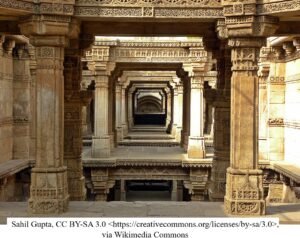Andala, also known as Godadevi, Kothai and Nachiyar, was the only female Alvar among twelve Hindu poets of South India. She was affiliated with the Shri Vaishnav tradition of Hindu tradition. She was posthumously considered an avatar of the Bhudevi.
It is believed that she lived in the middle of the seventh or eighth century CE. One of the Alvar, Periyalvar is said to have found her as a baby in the Tulsi Garden at the Srivilliputhur Temple, and adopted her. She was called Kodai – a garland/given by the Bhagwan. She later became known as Andal – one who rules.
Andal had intense love for Bhagwan. She grew with a constant determination to marry Bhagwan Ranganatha. She used to adorn herself daily with flower garland prepared for the Bhagwan at the Temple. After admiring her reflection and thinking of herself as his wife, she would put the garland back for her father to take to the temple and offer to the Bhagwan. One day he noticed a hair on the garland. He realized what was happening. He scolded her and prepared a new garland to offer to the Bhagwan. That night, the Bhagwan appeared in his dream and told him that He missed the scent of Goda‘s body hair smell. Her father realized his daughter’s love of Bhagwan. From that day onward she became known as Andal, the girl who ‘ruled’ over the Bhagwan. It is believed that Andal was married to the Bhagwan.
Andal was a great poet. As a teenage girl she composed the poems, which are regarded as unique in the literary, philosophical, religious and artistic content. Tiruppavai and Nacciyar Tirumoli are most famous work Tiruppavai, a poem with thirty verses, expresses purest love of Bhagwan, equivalent to love of Gopis. She imagines herself a cowherd girl during the incarnation of Bhagwan Krisna. She yearns to serve him and achieve happiness for eternity.
Nacciyar Tirumoli, is a poem of 143 verses. Tirumoli means sacred sayings in Tamil poetic style and Nacciya means Goddess, so the title means – sacred saying of Goddess. This poem fully reveals intense longing for Vishnu. Utilizing classical Tamil poetic conventions and intermixing stories from Vedas and Puranas, she created imagery that is quite possibly unparalleled in Indian religious literature. Andala is one of the most extraordinary personalities in the religious history of Bharat.
— Sanjay Mehta


